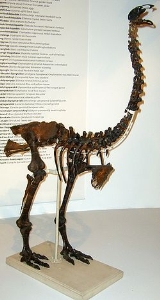
Eastern moa
Encyclopedia
The Eastern Moa, Emeus crassus, is an extinct
species of moa
. When the first specimens were originally described by Richard Owen
, they were placed within the genus
Dinornis as three different species, but, was later split off into their own genus, Emeus. E. crassus is currently the only species of Emeus, as the other two species, E. casuarinus and E. huttonii are now regarded as synonyms of E. crassus. It has been long suspected that the "species" described as Emeus huttonii and E. crassus were males and females, respectively, of a single species. This has been confirmed by analysis for sex-specific genetic markers of DNA extracted from bone material; the females of E. crassus were 15-25% larger than males. This phenomenon — reverse size dimorphism — is not uncommon amongst ratites, being also very pronounced in kiwi
s.
bones, hair
-like feathers (beige in this case), a long neck and large, powerful legs with very short, strong tarsi. It also had a sternum
without a keel and a distinctive palate
. Its feet were exceptionally wide compared to other moas, making it a very slow creature. Soft parts of its body, such as tracheal rings (cartilage) or remnants of skin were found, as well as single bones and complete skeletons. As they neared the head, the feathers grew shorter, until they finally turned into coarse hair; the head itself was probably bald.
, and lived in the lowlands (forests, grasslands, dunelands, and shrublands). Human
colonists hunted Emeus into extinction with relative ease. Like almost all moa, it was gone by the year 1500.
Extinction
In biology and ecology, extinction is the end of an organism or of a group of organisms , normally a species. The moment of extinction is generally considered to be the death of the last individual of the species, although the capacity to breed and recover may have been lost before this point...
species of moa
Moa
The moa were eleven species of flightless birds endemic to New Zealand. The two largest species, Dinornis robustus and Dinornis novaezelandiae, reached about in height with neck outstretched, and weighed about ....
. When the first specimens were originally described by Richard Owen
Richard Owen
Sir Richard Owen, FRS KCB was an English biologist, comparative anatomist and palaeontologist.Owen is probably best remembered today for coining the word Dinosauria and for his outspoken opposition to Charles Darwin's theory of evolution by natural selection...
, they were placed within the genus
Genus
In biology, a genus is a low-level taxonomic rank used in the biological classification of living and fossil organisms, which is an example of definition by genus and differentia...
Dinornis as three different species, but, was later split off into their own genus, Emeus. E. crassus is currently the only species of Emeus, as the other two species, E. casuarinus and E. huttonii are now regarded as synonyms of E. crassus. It has been long suspected that the "species" described as Emeus huttonii and E. crassus were males and females, respectively, of a single species. This has been confirmed by analysis for sex-specific genetic markers of DNA extracted from bone material; the females of E. crassus were 15-25% larger than males. This phenomenon — reverse size dimorphism — is not uncommon amongst ratites, being also very pronounced in kiwi
Kiwi
Kiwi are flightless birds endemic to New Zealand, in the genus Apteryx and family Apterygidae.At around the size of a domestic chicken, kiwi are by far the smallest living ratites and lay the largest egg in relation to their body size of any species of bird in the world...
s.
Description
Emeus was of average size, standing 1.5 to 1.8 m (4.9 to 5.9 ft) tall. Like other moa, it had no vestigial wingWing
A wing is an appendage with a surface that produces lift for flight or propulsion through the atmosphere, or through another gaseous or liquid fluid...
bones, hair
Hair
Hair is a filamentous biomaterial, that grows from follicles found in the dermis. Found exclusively in mammals, hair is one of the defining characteristics of the mammalian class....
-like feathers (beige in this case), a long neck and large, powerful legs with very short, strong tarsi. It also had a sternum
Sternum
The sternum or breastbone is a long flat bony plate shaped like a capital "T" located anteriorly to the heart in the center of the thorax...
without a keel and a distinctive palate
Palate
The palate is the roof of the mouth in humans and other mammals. It separates the oral cavity from the nasal cavity. A similar structure is found in crocodilians, but, in most other tetrapods, the oral and nasal cavities are not truly separate. The palate is divided into two parts, the anterior...
. Its feet were exceptionally wide compared to other moas, making it a very slow creature. Soft parts of its body, such as tracheal rings (cartilage) or remnants of skin were found, as well as single bones and complete skeletons. As they neared the head, the feathers grew shorter, until they finally turned into coarse hair; the head itself was probably bald.
Range and habitat
Eastern moa lived only on the South IslandSouth Island
The South Island is the larger of the two major islands of New Zealand, the other being the more populous North Island. It is bordered to the north by Cook Strait, to the west by the Tasman Sea, to the south and east by the Pacific Ocean...
, and lived in the lowlands (forests, grasslands, dunelands, and shrublands). Human
Human
Humans are the only living species in the Homo genus...
colonists hunted Emeus into extinction with relative ease. Like almost all moa, it was gone by the year 1500.
External links
- Eastern Moa. Emeus crassus. by Paul Martinson. Artwork produced for the book Extinct Birds of New Zealand, by Alan Tennyson, Te Papa Press, Wellington, 2006

